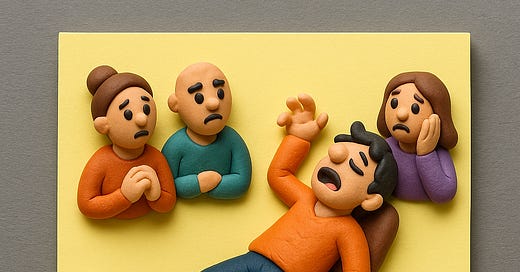Neuro Post-It 11: why did I do that?
A new series of neuroscientific digestible insights! Written in collaboration with Cesca Centini.
Disclaimer: again, our intention isn't to simplify the complex world of human behavior into small concepts. Instead, we're focusing on the fascinating neurobiology behind empathy and social behavior, which can be thought of as an entry point into a larger discussion bridging the gap between neuroscience, philosophy, and everyday experience. Enjoy!
Introduction
We constantly ask ourselves why we behave in certain ways, why we feel connected to others, why some days we NEED social interaction while others we need to be left alone eating ice cream, and why we instinctively mirror someone else's smile or yawn (or puking… ah no, that’s another story).
What's behind these seemingly simple behaviors?
We will cover what is nowadays defined (neuro-scientifically) as behavior, the magic behind empathy and mirroring actions, how the social brain works and what you can do to improve it!
What even is “behavior”? [bɪˈheɪ.vjɚ]
Before understanding why we behave, let's clarify what behavior actually is.
According to neuroscientists Gomez-Marin and Ghazanfar (paper below), behavior isn't just stimulus-response. Instead, it’s linked to materiality, agency, and historicity.
Materiality - behavior is embodied and situated
"No behavior without a body, no body without an environment."
Behavior isn’t just the brain acting in an isolated environment: it’s grounded in physical constraints. You don’t just "intend" to move: you have muscles, joints, sensory input, and a context that make that movement possible, meaningful, or restricted. This is why studying rats in a closed environment doesn’t actually show the truthfulness of their behavioral choices: you should study them without interfering with their environment.
Think of the mirror neuron system: its importance lies not just in internal resonance, but in how observed actions and executed actions are embodied in real, material space.
Examples:
The way your posture changes in a crowded room vs. when you're alone (and no one is watching….maybe👀).
Social gaze behaviors: constrained by eye mechanics and spatial positioning (1to1 awkward conversations).
Agency - the organisms act, doesn’t simply react
"Behavior is not just what is done to an animal, but what the animal does."
This is the most fundamental concept: the brain is not just passively responding to external stimuli, it's actively generating behavior. Even when you sit still, you’re not a passive receiver: you’re interpreting, predicting, preparing.
In neuroscience, this is reflected in internal motor planning, intention encoding in premotor and prefrontal areas, and spontaneous neural dynamics.
Behavior is about what the organism wants, predicts, and decides to do.
Example:
A baby babbling long before it can speak: he/she/they are exploring vocal patterns through self-driven action.
Historicity - behavior “has” memory
"No behavior is entirely here-and-now."
Every action is shaped by the past. Not just in a deep evolutionary sense (as in “our ancestors survived because...”), but in your own personal experience.
Your behavior today—how you react to a face, a tone, or a situation—is colored by everything that came before: your habits, traumas, learning, conditioning (now you really wish you started therapy, uh?).
In the brain, this plays out through neuroplasticity, reinforcement learning, memory traces, and even epigenetics. Behavior is temporal, unfolding in sequences and routines. This is what makes humans and animals capable of learning, adapting, and developing complex social behavior.
🔑: Behavior isn't random: it’s your brain’s attempt to navigate a complex world based on goals, sensory information, and previous experience.
Magic of empathy
You smile; I smile.
You cry; I feel sad.
Why?!
Neuroscience identified empathy as an incredibly powerful human ability rooted in specific brain regions that allow us to literally "feel with" others (Decety & Lamm, paper below).
Empathy involves two crucial steps:
Emotion Sharing (bottom-up): your brain mirrors the emotions you see in others.
Regulation and Control (top-down): you modulate your emotional reaction to avoid confusion between your feelings and someone else's.
This mirroring relies partly on, obviously, mirror neurons. First discovered in monkeys, mirror neurons activate both when you perform an action and when you see someone else doing it (Gallese, paper below). This is known as "embodied simulation," a process that makes social identification, empathy, and connectedness possible.
Your social brain
Man is by nature a social animal - Aristotle
And he didn’t get it wrong: we’re inherently social beings.
Our brains have evolved specific neural circuits designed explicitly to handle social interactions, which are fundamental for survival, reproduction, and cooperation (Chen & Hong, paper below).
Social behaviors aren’t just passive reactions. They are decisions made through dynamic feedback loops: you observe → interpret → react → observe again → adjust → and repeat.
The main brain regions involved in these interactions include:
the amygdala for assessing emotional relevance.
the medial prefrontal cortex (mPFC) for interpreting social cues and intentions.
the anterior insula for processing emotions and bodily sensations involved in empathy.
finally, the reward systems for encouraging behaviors beneficial for social bonding.
In other words, your brain is continuously adapting and learning from every interaction you have.
So… can you improve your social brain?
Absolutely.
Social neuroscience suggests our social behaviors are flexible, adaptive, and shaped by experience (Adolphs, paper below). Just as muscles strengthen with exercise, your social brain circuits become more efficient through social experiences, empathy training, and reflective practices.
It’s like public speaking, the more you do it, the more you get “better” at it.
Every interaction, both positive and negative, is a form of training for your brain, subtly influencing how you'll react next time.
Resources
Gomez-Marin, A., & Ghazanfar, A. A. (2019) The Life of Behavior
Gallese, Mirror neurons and the neural basis of empathy. Handbook of Clinical Neurology, 151, 219–233.
Chen, P., & Hong, W. (2018). Neural Circuit Mechanisms of Social Behavior. Neuron, 98(1), 16–30.
Decety, J., & Lamm, C. (2006) Human empathy through the lens of social neuroscience. TheScientificWorldJournal, 6, 1146–1163.
Co-written beautifully with the outrageously amazing
.








